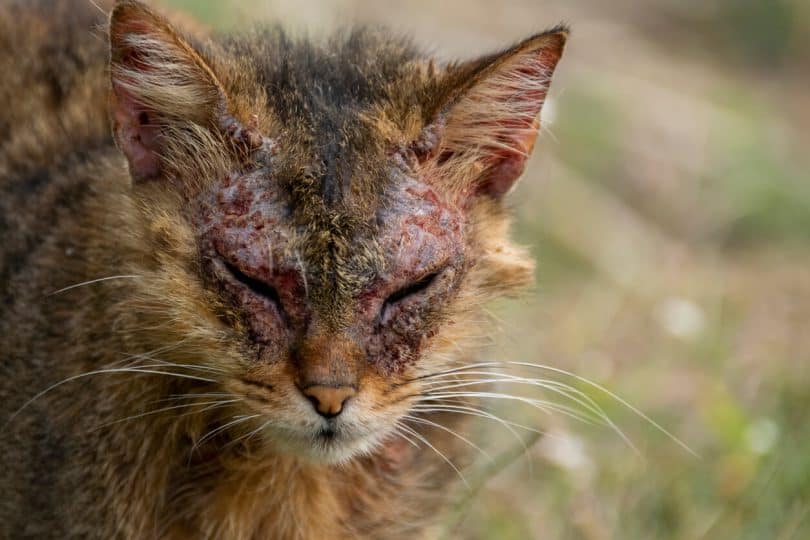- Not a substitute for professional veterinary help.
Mange is a highly contagious disease that only rarely affects cats. It’s caused by an infestation of mites that live under the skin and involves symptoms like fur loss, inflammation, and intense itching.
This condition isn’t just uncomfortable for your cat. These mites spread through direct contact with other animals, so mange can spread to other pets in your home—and you as well. However, it’s very treatable, and your vet can prescribe a number of effective medications to relieve your cat’s symptoms.
What’s more, while. mites can infect humans, they can’t reproduce on your skin, explains Dr. Linda Simon, MVB, member of the Royal College of Veterinary Surgeons and veterinarian at Cat World. In short, they can’t complete their life cycle, so you can typically get rid of them pretty easily.
Read on to get the details on different types of mange, signs to pay attention to, and treatment options.
Symptoms
Dr. Simon describes feline mange as a serious skin disease. The main symptoms include:
- Extreme itching: You may notice your cat constantly scratches certain parts of their bodies, or all over. They may seem restless or even lose weight due to frequent scratching and moving around.
- Hair loss: Your cat may start to lose fur in the areas they continuously scratch and groom.
- Scabs: These usually look like small red pimples.
- Crusting: Your cat’s skin may become thick and crusty, especially around their face and ears.
You might easily mistake these symptoms for an ear mite infection—and your cat is much more likely to have ear mites. They could also have an allergy or even cat acne! That’s why it’s so important to make an appointment with your veterinarian. They can examine your cat and make the right diagnosis.
How Common Is Mange?
Cats have a relatively low chance of developing mange, generally speaking. Research including pet cats and stray cats in Europe suggests only about 0.2% of pets have mange, while about 2.4% of strays have this condition.
Dogs get mange more often, but the mange that usually affects dogs is another type called sarcoptic mange.
Cats generally develop notoedric mange, but they can also have other types, including:
- cheyletiellosis (often picked up from rabbits)
- canine sarcoptic mange (from contact with infected dogs)
- ear mites
The prevalence of mange varies depending on the time of year, weather conditions, and region where you live. Mange more often affects stray and feral cats who spend most of their time outside and don’t receive regular mite prevention.
What causes mange?
Mange is caused by a type of parasite or mite that infects the skin.
The different types of mites that can cause mange include:
- Notoedric mange, also known as feline scabies.
- Sarcoptic mange, also known as canine scabies, can infect cats and rabbits as well as dogs.
- Demodetic mange. This non-contagious mite normally lives on feline skin, but it can get out of control in sick or senior. cats.
Notoedres cati is the mite that causes feline scabies. These mites burrow into the skin, with females laying 2-3 eggs per day. The life cycle of a mite lasts around 14-21 days in favorable conditions.
How Contagious Is Mange?
Although rare, mange is highly contagious between cats, as well as dogs, humans, and rabbits. If your cat comes into contact with another infected animal, they can develop mange. If you cuddle a cat with mange, the mites can spread to you.
Dr. Simon says contact with infested items can also lead to an infection, since mange mites can live for a short time on things like blankets, grooming tools, and bedding. .
Feline scabies is not the same thing as human scabies, which is caused by a different type of mite—one you can’t get from a pet.. If you get mange from your cat, the mites can’t reproduce on your skin and will usually die within a day or two. You may feel some mild itching and irritation, but the condition isn’t serious for people.
That said, you run the risk of getting re-infected by new mites as long as your cat has mange. In short, getting timely treatment for your cat is the best option for you both!
Is mange fatal in cats?
In some rare cases, cats may die of complications related to mange.
Kittens whose immune systems haven’t fully developed and sick cats with compromised immune systems have a higher risk of death. This is because they may have a harder time coping with the extra demands mites put on the body, according to Dr. Simon.
Mange can also become fatal if it goes undiagnosed for longer than 4 or 5 months. So if you suspect your cat might have mange, it’s important to have your vet check them out as soon as possible—especially if they’re very young, very senior, or have underlying health conditions.
Other possible complications of mange include mutilation of the ears and otitis externa, an infection that can lead to deafness.
How To Treat Mange In Cats
To diagnose mange, your vet will take skin scrapings and review them under a microscope. If your cat has mange, they may recommend one of several different treatments.
Dr. Simon shares some of the most common treatments for mange in the table below:
| Treatment | Efficacy | Safety | Side effects | Expense | Time to work | Type | Vet recommended? |
| Ivermectin | Effective for cheyletiellosis and notoedric mange | Very safe at correct dose | Lethargy, vomiting, and wobbly walking. At the correct dose, side effects are uncommon | Very affordable | Several weeks | Oral | Yes |
| Dipping | Lime sulfur and Amitraz are highly effective | Safe at correct dose | Skin irritation and fur loss possible if not diluted correctly | Very affordable | 4-8 weeks | Topical | Not commonly used for cats |
| Isoxazoline flea control products like fluralaner (Bravecto), lotilaner (Credelio), and saralaner (Revolution Plus) | Up to 100% with 2 applications, depending on type of mange and product used | High margin of safety | Vomiting, diarrhea, itching | About $18-22 per treatment | 48 hours for ear mites, several weeks for notoedric mange | Topical | Yes |
| Selamectin | Highly effective, though specific results can depend on the type of mange | Wide margin of safety | Neurological symptoms rarely reported | About $12-15 per treatment | About 4 to 7 weeks for full resolution | Topical | Yes |
| Baby oil | No proven efficacy | Safe | May cause loose stool and vomiting if ingested | Inexpensive | No proven efficacy | Topical | No |
As mange is relatively uncommon in cats, very few products have received approval from the Food and Drug Administration (FDA) to specifically treat mange in cats.
Your vet may prescribe these medications off-label, which means they have another intended use (like treating fleas)—but they can still work very effectively to treat mange.
How To Prevent Mange
The good news: As a pet parent, you can take steps to prevent feline mange.
A good first step involves regular visits to your vet. A yearly checkup once or twice a year can help your vet spot the signs of health concerns like mange early—before they become serious. You’ll also want to take your cat to the vet as soon as you notice any unusual behaviors, like constant scratching.
Dr. Simon also recommends keeping pet cats away from stray and feral cats. You can also keep your cat from coming into contact with potentially infected animals, like rabbits, by discouraging them from hunting. For example, keep them indoors or give them supervised outside time on a leash walk or in an enclosed catio.
Giving them a regular dose of preventative parasite medication like moxidectin, selamectin, or ivermectin can also help. Parasite prevention is especially important for cats who regularly spend time outside or around other cats.
What To Do When Your Cat Has Mange
Whenever possible, Dr. Simons recommends isolating cats with mange in a separate room while the treatment runs its course.
Your vet can offer further guidance on how to separate your cat from other pets in your home, since the treatment and isolation period may vary depending on the type of medication they receive. They may also want to examine your other pets for mange.
Mites can’t survive and reproduce without a host. Even so, Dr. Simon also recommends thoroughly cleaning your home by washing bedding in hot water and vacuuming carpeting and soft furnishings daily to help prevent re-infestation. It’s typically not necessary to call an exterminator, though.







